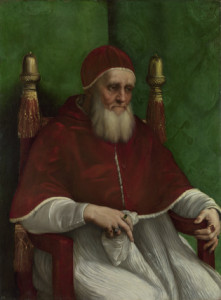PREVIOUS: LEONARDO DA VINCI – THE VIRGIN OF THE ROCKS
Raphael: Portrait of Pope Julius II: 1511
Here we’re looking at Pope Julius seated in a chair that is decorated with carvings of acorns. The painting has only three main colours – red, green and white – and a very plain background that puts all the attention on the sitter. He isn’t looking at us, but appears deep in thought, and, unusually for papal portraits, he is bearded.
In fact, if you had seen this picture for the first time in 1511 you might have been shocked. Until then portraits of popes had been idealised, typically kneeling in profile or square on, but this attempts to be a realistic portrayal. It’s from the period known as the high renaissance when artists aimed to capture the character of the sitter and represent some of their inner emotions. Look at how expressive his hands are – one is loosely holding a handkerchief, the other seems to be gripping the chair. Vasari said of this picture that it was so true to life it caused those who saw it “to tremble as if it was the living man himself”. This is a trendsetting piece of art as it established a style for ‘intimate’ papal portraits that was to last for over 200 years. It is believed that Raphael painted up to nine versions of the portrait – but this is now thought to be the ‘prime’ version and that the others are copies of this.
In the green wall hangings you can make out the cross keys that represent St Peter and the Vatican, and the acorns on the chair are an allusion to Julius’s family name – della Rovere, or ‘from the oak’. Painting in oils allows for fine detail and the expression of texture, and here Raphael demonstrates his mastery of that – note the contrast between the hardness of the jewels in the Pope’s rings and the softness of the fur trim on his cape and the silk of his white robe.
Those rings show the wealth of the papacy. These days we think of Popes as having a purely spiritual role as head of the Catholic church, but in the past the Pope would also be the ruler of large parts of Italy and the head of a powerful army. Julius’s military exploits led him to be called the ‘warrior Pope’; he wasn’t always victorious – he grew his beard as a sign of mourning after the French captured the city of Bologna from the Papal state – but the lands the Papacy owned and conquered made the Vatican very rich.
This wealth financed great art works. It was Julius who ordered the rebuilding of St Peter’s in Rome that gave us the massive church that exists today, as well as commissioning Raphael to paint the frescos on the walls and Michelangelo to produce that masterwork of the high renaissance, the ceiling of the Sistine Chapel.
And one more fact about Julius relevant to us in England – when Arthur, Prince of Wales died, Julius gave permission for the widow to marry his brother. That widow was Katherine of Aragon, and the brother became Henry VIII.
If you’d like to go face to face with this picture and have me tell you all about it, you can find out details and dates of my National Gallery guided tours here.


